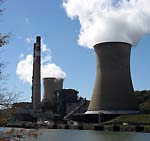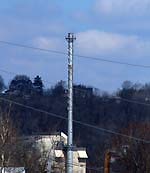What's polluting our air?
Mercury
Coal-burning power plants are the single largest source of mercury emissions locally and nationwide. The EPA does not currently regulate mercury emissions from these power plants. Other smaller sources of mercury emissions include electronics manufacturing, chlorine/alkaline soda manufacturing, certain mines, and waste incinerators.

Fort Martin Power Plant
After mercury is released into the air, it is deposited into water and soil, where it is converted to a more toxic form called methylmercury. Methylmercury is ingested by fish and accumulates in their tissues over time. Humans are exposed to methylmercury when they eat fish caught in contaminated waters.
Exposure to methylmercury in the womb, in infancy, or in childhood can cause neurological damage in the form of learning disabilities, language and attention deficits, and motor problems. Higher levels of exposure cause more severe neurological problems. Methymercury is transferred via breast milk to nursing infants.
The US EPA estimates that approximately 6 - 7% of American women of childbearing age have blood levels of mercury that put their babies at risk of neurological damage. Estimates from a study being done by Greenpeace showed 21% of American women in the danger zone.
To minimize exposure to mercury, the US EPA recommends limiting the amount fish and shellfish eaten by women and young children. The WV Department of Health and Human Services places even more stringent limits on the amount of fish caught in West Virginia's waterways that can safely be eaten.
Particulate Matter

Traffic in Morgantown Particulate matter comes in coarse (PM10) and fine (PM2.5) varieties. Fine particulates pose a greater risk to human health. The major source of fine particulates in this area is coal-fired power plants, with vehicle and industrial emissions also contributing. Fine particulates can trigger asthma attacks and worsen symptoms of lung diseases such as chronic bronchitis and emphysema. A recent study showed that children raised in California cities with the highest levels of particulate pollution have impaired lung development approximately equal to that of children whose mothers smoke. In 2004, the American Heart Association has recognized particulate pollution as a risk factor for developing and dying from heart disease.
Particulate pollution is also a major source of haze and causes soot deposition on buildings, monuments, and statues.
Ozone
Ozone is formed when a chemical reaction occurs between sunlight and various pollutants released by vehicles, power plants, and industry. Natural sources of ozone exist as well. Ozone can trigger asthma attacks and worsen symptoms of other lung diseases. As with particulate matter, growing up in a high-ozone area can stunt lung development in children. Ozone also increases the risk of developing respiratory infections.
Sulfur Dioxide
The major source of sulfur dioxide in our area is coal-burning power plants. Sulfur dioxide causes acid rain and haze. Its health effects include irritation of the lungs, worsening of lung disease and heart disease symptoms.
Nitrogen Oxides

Smoke stack, Morgantown
Nitrogen oxides (NOx) are released from coal burning power plants, vehicular exhaust, and industry. They form ground-level ozone via a chemical reaction with VOCs and sunlight, are major component of smog, and contribute to the greenhouse effect.
Carbon Dioxide
Carbon dioxide is released whenever coal, oil, natural gas, or wood is burned. Decomposition of organic matter produces carbon dioxide as well. Carbon dioxide is a major contributor to the greenhouse effect.
Other Pollutants
Arsenic, lead, volatile organic compounds (VOCs), dioxins, and polycyclic aromatic hydrocarbons (PAHs) are other air pollutants that can cause nerve damage, cancer, or both.